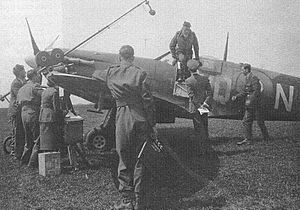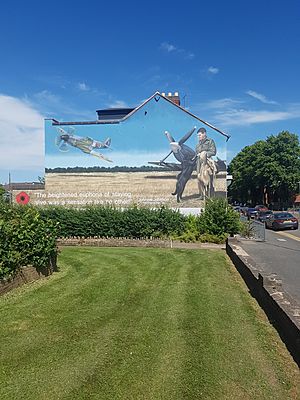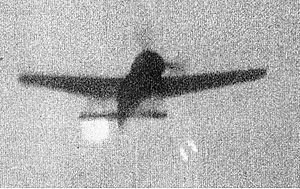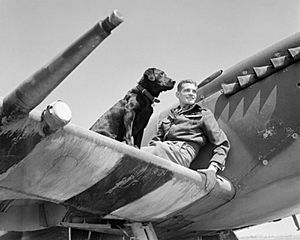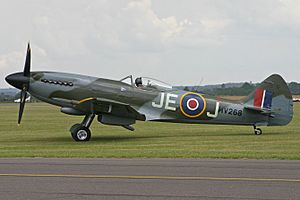Johnnie Johnson (RAF officer) facts for kids
Quick facts for kids
Johnnie Johnson
|
|
|---|---|

Wing Commander Johnson at Bazenville Landing Ground, Normandy, July 1944, with his Labrador, Sally
|
|
| Nickname(s) | "Johnnie" |
| Born | 9 March 1915 Barrow upon Soar, Leicestershire |
| Died | 30 January 2001 (aged 85) Buxton, Derbyshire |
| Allegiance | United Kingdom |
| Service/ |
Royal Air Force |
| Years of service | 1939–1966 |
| Rank | Air vice marshal |
| Service number | 754750 (airman) 83267 (officer) |
| Commands held | No. 610 Squadron (1942–43) No. 144 Wing (1944) No. 127 Wing (1944–45) No. 125 Wing (1945) No. 124 Wing (1945–46) RAF Wildenrath (1952–54) RAF Cottesmore (1957–59) Air Forces Middle East (1963–65) |
| Battles/wars | Second World War Korean War |
| Awards | Companion of the Order of the Bath Commander of the Order of the British Empire Distinguished Service Order & Two Bars Distinguished Flying Cross & Bar Officer of the Order of Leopold with Palms (Belgium) Croix de guerre (Belgium) Legion of Merit (US) Distinguished Flying Cross (US) Air Medal (US) Commander of the Legion of Honour (France) |
| Other work | Deputy lieutenant for the County of Leicestershire |
Air Vice Marshal James Edgar Johnson, nicknamed "Johnnie", was a famous English Royal Air Force (RAF) pilot and flying ace during the Second World War. He was born on 9 March 1915 and passed away on 30 January 2001.
Johnnie grew up in the East Midlands and became an engineer. He loved sports, but a rugby injury to his collarbone made it hard for him to become a fighter pilot. He really wanted to join the RAF and, after being turned down a few times, he was finally accepted in August 1939. His old injury caused problems during his early training, so he missed the big air battles of 1940, like the Battle of Britain.
After an operation to fix his collarbone, Johnnie started flying regularly in 1941. He flew many missions over German-controlled Europe, fighting in major events like the Dieppe Raid and the Battle of Normandy. By the end of the war, he was a group captain. Johnnie was credited with shooting down 34 enemy planes by himself, and sharing in seven more victories. He was the most successful Western Allied fighter ace against the German Luftwaffe (air force).
After the war, Johnnie stayed in the RAF and even served in the Korean War. He retired in 1966 as an air vice marshal. He kept his passion for aviation alive, giving talks and getting involved in aviation art. Johnnie Johnson remained active until he died from cancer in 2001.
Early Life and Dreams of Flying
Johnnie Johnson was born on 9 March 1915 in Barrow upon Soar, Leicestershire. He grew up in Melton Mowbray, where his father was a police officer. Johnnie's uncle, Edgar Charles Rossell, helped pay for his education at Loughborough Grammar School. Johnnie was a very principled person, once almost getting expelled for refusing a punishment he thought was unfair. He enjoyed shooting and sports in the countryside.
Johnnie went to University College Nottingham (now the University of Nottingham) and became a civil engineer at 22. He worked as a surveyor and then an assistant engineer. In 1938, he broke his collarbone playing rugby. The injury didn't heal right, which caused him trouble later when he wanted to fly.
Johnnie started taking flying lessons on his own. He tried to join the Royal Auxiliary Air Force, but felt he was rejected because of his social class. As war seemed more likely, the RAF started accepting more people from different backgrounds. Johnnie tried again to join the Royal Air Force Volunteer Reserve (RAFVR). He was turned down again because of his injury and too many applicants.
Not giving up, Johnnie joined the Leicestershire Yeomanry, a part of the army. He famously said, "If I've got to fight Hitler I'd sooner fight him in one of those than on a bloody great horse!" after seeing Hawker Hurricane fighters.
Learning to Fly
In August 1939, Johnnie was finally accepted into the RAFVR. He began training on weekends, learning about flying on a de Havilland Tiger Moth biplane. When World War II started in September 1939, Johnnie became a sergeant. He was chosen for fighter pilot training.
By December 1939, Johnnie started his main flight training. He flew solo for the first time on 29 February 1940. After more training, he earned his "wings" on 7 August 1940 and became a pilot officer.
On 19 August 1940, Johnnie flew a Supermarine Spitfire for the first time. During one training flight, he crashed a Spitfire because his harness was too loose, hurting his shoulders. This showed his old rugby injury was still a problem. He tried to hide the pain, but it made flying difficult, especially when diving. Despite this, he completed his training.
Injury Problems Return
In August 1940, Johnnie was briefly with No. 19 Squadron RAF and then No. 616 Squadron RAF. On 11 September 1940, he flew a patrol that qualified him for the Battle of Britain clasp.
His old injury kept bothering him, making it painful to fly fast planes like the Spitfire. RAF doctors gave him a choice: have an operation and miss the Battle of Britain, or become a training instructor. Johnnie chose the operation. He was sent to a hospital and didn't return to his squadron until 28 December 1940. After a test flight, he was cleared to fly again.
World War II: Fighting in the Skies
Johnnie returned to flying in early 1941 with 616 Squadron, which was part of the Tangmere Wing. He often flew with famous pilots like Wing Commander Douglas Bader. On 15 January 1941, Johnnie helped damage a German Dornier Do 17 bomber. This was the only time he fought a German bomber.
For a while, Johnnie flew as a night fighter pilot, but it was hard to find German bombers without radar. On 22 February 1941, he damaged a Messerschmitt Bf 110. Soon after, his squadron moved to RAF Tangmere on the English Channel coast, ready for more action.
In 1941, the RAF started flying "offensive sweeps" over Belgium and France. These were called "Circus" attacks, where small groups of bombers were protected by many fighters. The goal was to make the German Luftwaffe come out and fight.
First Victories and New Tactics
Johnnie's first encounter with German fighters didn't go well. He shouted a warning at the wrong time, causing his section to break formation. This earned him a telling-off from Douglas Bader.
Johnnie disliked "Rhubarb" missions, which involved ground attacks, because many skilled fighter pilots were lost this way. Pilots like Eric Lock and Paddy Finucane were killed on such missions. Johnnie and other pilots suggested better formation tactics to avoid surprise attacks. Bader agreed, and they started using more flexible formations, similar to the German "finger-four" formation. This helped RAF pilots stay safer and spot enemies better.
On 26 June 1941, Johnnie got his first air victory. While on a mission, he saw a Messerschmitt Bf 109 fly in front of him. He fired, and the German pilot bailed out. This was one of five planes lost by the German Jagdgeschwader 2 (Fighter Wing 2) that day.
More action followed. On 14 July, Johnnie shot down another Bf 109. He then chased and hit another, but couldn't confirm it due to oil on his windscreen. On 21 July, he shared in destroying another Bf 109. On 23 July, he damaged another Bf 109 in a battle where German ace Adolf Galland was wounded.
Johnnie was part of the mission on 9 August 1941 when Douglas Bader was lost over France. During this chaotic battle, Johnnie shot down a lone Bf 109, his fourth victory. He ended the month with a probable victory. On 4 September 1941, Johnnie was promoted to flight lieutenant and received the Distinguished Flying Cross (DFC).
On 21 September 1941, Johnnie achieved his fifth and sixth victories, shooting down two more Bf 109s. This made him an official flying ace. For the winter of 1941, Johnnie and 616 Squadron moved to training duties.
Facing New Challenges
In April 1942, the RAF resumed its offensive operations. Johnnie flew many missions that month. However, the Germans had a new, powerful fighter: the Focke-Wulf Fw 190. It was faster and more heavily armed than the Spitfire V, which the RAF was flying. This new enemy caused more casualties for Spitfire squadrons. Johnnie damaged an Fw 190 on 15 April 1942, but he saw how tough they were to fight.
Yes, the 190 was causing us real problems at this time. We could out-turn it, but you couldn't turn all day. As the number of 190s increased, so the depth of our penetrations decreased. They drove us back to the coast really.
On 26 June 1942, Johnnie received a bar to his DFC, meaning he had earned it a second time. On 10 July 1942, he was promoted to squadron leader and given command of 610 Squadron.
Johnnie continued to push for the "finger-four" formation, which was much safer in combat. He also disliked ground-attack missions for highly trained fighter pilots and avoided them when he could.
During the Dieppe raid on 19 August 1942, Johnnie shot down an Fw 190 and shared in destroying a Bf 109F. Later that year, his squadron moved north to protect the Royal Navy fleet.
After Christmas, Johnnie took command of No. 127 Wing RCAF and they received the new Spitfire Mk. IX, which was better against the Fw 190. Johnnie chose Spitfire EN398 as his personal plane, and his initials "JE-J" were painted on it. His call sign became "Greycap."
Johnnie made sure his wing used the finger-four formation, which helped them spot enemies and launch surprise attacks. He also stopped doing ground-attack missions. His wing escorted American bombers, and on one mission, Johnnie destroyed an Fw 190, his eighth victory.
The spring of 1943 was busy. Johnnie claimed three Fw 190s damaged. On 11 and 13 May, he destroyed two Fw 190s, bringing his total to ten individual victories. He also shared in destroying a Bf 109 on 1 June. He shot down five more Fw 190s in June, bringing his total to 15.
Johnnie had more success in July, shooting down three Bf 109s while escorting American bombers. His wing's successful tactics earned them the nickname "Wolfpack." Johnnie scored his 19th to 21st victories in August and September 1943, all against Fw 190s.
From Normandy to Germany
Before the D-Day landings in Normandy, Johnnie continued to score victories. On 25 April 1944, he achieved his 22nd and 23rd victories, becoming the highest-scoring ace still flying missions. He shot down another Fw 190 on 5 May.
After the Allied invasion of France on 6 June 1944, Johnnie added five more victories that month, including two Bf 109s on 28 June. His wing was the first to be based on French soil after the invasion. This allowed them to fly further and score many more victories throughout the summer.
On 21 August 1944, Johnnie shot down two Fw 190s over the Seine River near Paris. This brought his total to 32 and 33 victories, surpassing Sailor Malan's record. However, Johnnie felt Malan's achievements were even greater because Malan fought when the odds were much more against the RAF.
Malan had fought with great distinction when the odds were against him. He matched his handful of Spitfires against greatly superior numbers of Luftwaffe fighters and bombers. He had been forced to fight a defensive battle over southern England and often at a tactical disadvantage, when the top-cover Messerschmitts [Bf 109s and Bf 110s] were high in the sun. I had always fought on the offensive, and, after 1941, I had either a squadron, a wing or sometimes two wings behind me.
In September 1944, Johnnie's wing supported Operation Market Garden in the Netherlands. On 27 September 1944, he scored his last victory of the war over Nijmegen, shooting down a Bf 109.
The wing saw few enemy planes for the rest of the year. On 1 January 1945, during a large German attack called Operation Bodenplatte, Johnnie saw German planes attacking his airfield. He noted that the German pilots seemed inexperienced. He led a Spitfire patrol but didn't engage any enemy planes as there was no second attack.
In March 1945, Johnnie's wing moved into Germany as Allied armies advanced. There was little sign of the Luftwaffe, so they mostly flew ground-attack missions. On 26 March, Johnnie was promoted to group captain. Days later, he took command of No. 125 Wing. On 5 April, after landing his Spitfire, a Bf 109 flew overhead and tried to attack. Johnnie took cover while airfield defenses shot down the enemy plane.
In the last week of the war, Johnnie's squadron flew patrols over Berlin and Kiel. On one mission, they attacked German airfields and destroyed 11 Bf 109s on the ground. On another, they shot down an enemy transport plane. Once, Johnnie's unit even escorted four German Fw 190s to an RAF airfield after the German pilots signaled they were surrendering.
After Germany surrendered in May 1945, Johnnie's unit moved to Copenhagen, Denmark. For his service, he received the Croix de Guerre with Palm and the rank of officer of the Order of Léopold with Palms from Belgium.
Life After the War
After the war, Johnnie stayed in the RAF and was given a permanent commission. He became the Officer Commanding Tactics at the Central Fighter Establishment.
Korean War and Beyond
In 1950, Johnnie served in the Korean War as part of an exchange program with the US Air Force. He flew Lockheed F-80 Shooting Star and North American F-86 Sabre jets. He received the US Air Medal and Legion of Merit for his service there.
In 1952, he was promoted to group captain and commanded RAF Wildenrath in West Germany until 1954. From 1954 to 1957, he worked at the Air Ministry in London. In 1956, his wartime memoir, Wing Leader, was published. In 1957, Johnnie became commanding officer of RAF Cottesmore in the UK, which operated Victor V bombers.
In 1960, he was promoted to air commodore and later became a Commander of the Order of the British Empire (CBE). On 1 October 1963, he was promoted to air vice marshal and served as air officer commanding (AOC) RAF Middle East in Aden.
In 1964, he published another book, Full Circle, about the history of air fighting. In 1965, he retired from the RAF and was appointed a Companion of the Order of the Bath (CB).
Later Years
In 1967, Johnnie became a deputy lieutenant for Leicestershire. He also started the Johnnie Johnson Housing Trust, which managed over 4,000 properties by 2001.
After Douglas Bader passed away in 1982, Johnnie helped set up the Douglas Bader Foundation to support charities for disabled people. Johnnie also helped promote the work of aviation artist Robert Taylor, whose paintings of aircraft and battles became very popular.
Johnnie spent his later years giving speeches, raising money for causes, and enjoying his hobbies like fishing, shooting, and walking his dogs. He appeared on the British TV show This Is Your Life on 8 May 1985, the 40th anniversary of VE Day. German fighter ace Walter Matoni was a guest on the show, and they met for the first time, clearing up old wartime rumors.
Personal Life
Johnnie Johnson married Pauline Ingate in Norwich on 14 November 1942. They had two sons, Michael (born 1944) and Chris (born 1946). After they separated, Johnnie lived in Buxton, Derbyshire with his partner, Janet Partridge.
Johnnie passed away from cancer on 30 January 2001, at the age of 85. A memorial service was held for him. His ashes were scattered on the Chatsworth estate in Derbyshire. A bench was dedicated to him at his favorite fishing spot, with the inscription "In Memory of a Fisherman."
List of Air Victories
Johnnie Johnson flew 515 missions during the war. He was credited with destroying 34 enemy aircraft by himself, and sharing in seven more victories. He also claimed three probable victories and damaged 10 aircraft. All his victories were against enemy fighters.
As a wing leader, Johnnie used his initials "JE-J" on his planes. He scored most of his victories flying two Spitfire Mk IXs: EN398/JEJ (12 victories and five shared) and MK392/JEJ (12 victories and one shared). His last victory was in MK392/JEJ.
| Chronicle of aerial victories | |||||
|---|---|---|---|---|---|
| Claim No. | Date | Location | Flying | Aircraft type | Notes |
| 15 Jan 1941 | Spitfire IA K4477 | Dornier Do 17 half-share damaged | |||
| 1. | 26 June 1941 | Near North Coates | Spitfire IA K4477 | Messerschmitt Bf 109 | Johnnie saw the pilot bail out. |
| 4 July 1941 | Gravelines | Spitfire IIA P7837 | Messerschmitt Bf 109 damaged | ||
| 2. | 6 July 1941 | South of Dunkirk | Spitfire IIA P7837 | Messerschmitt Bf 109 | |
| 3. | 14 July 1941 | Fauquembergues | Spitfire VB P8707 | Messerschmitt Bf 109 | |
| 21 July 1941 | Merville, Nord | Spitfire IIA P7837 | Messerschmitt Bf 109 half-share "probable". | ||
| 23 July 1941 | 10 miles inland from Boulogne | Spitfire IIA P7837 | Messerschmitt Bf 109 damaged | ||
| 4. | 9 August 1941 | Over Béthune | Spitfire VB W3334 | Messerschmitt Bf 109 half-share Bf 109 destroyed |
|
| 21 August 1941 | 10 miles east Le Touquet | Spitfire VB W3457 | Messerschmitt Bf 109 "probable" | ||
| 4 September 1941 | Le Touquet | Spitfire VB W3432 | Messerschmitt Bf 109 half-share "probable" | ||
| 5–6. | 21 September 1941 | Near Le Touquet | Spitfire VB W3428 | Two Messerschmitt Bf 109s | |
| 15 April 1942 | Le Touquet | Spitfire VB BM121 | Focke-Wulf Fw 190 damaged | ||
| 7. | 19 August 1942 | Dieppe | Spitfire VB EP215 "DW-B" | Focke-Wulf Fw 190 Fw 190 a half-share damaged third-share Bf 109F destroyed |
Claimed during the Dieppe Raid. |
| 20 August 1942 | Off French Coast | Spitfire VB EP215 | Focke-Wulf Fw 190 "probable" | ||
| 13 February 1943 | Near Boulogne | Spitfire IX EP121 | Focke-Wulf Fw 190 "probable" | ||
| 8. | 3 April 1943 | Montreuil, Pas-de-Calais | Spitfire IX EN398 | Focke-Wulf Fw 190 | First operation as Kenley Wing Leader. |
| 5 April 1943 | Ostend-Ghent area | Spitfire IX EN398 | Three Focke-Wulf Fw 190 damaged | ||
| 9. | 11 May 1943 | Gravelines | Spitfire IX EN398 | Focke-Wulf Fw 190 | |
| 10. | 13 May 1943 | Berck-Le Touquet | Spitfire IX EN398 | Focke-Wulf Fw 190 third-shared Fw 190 destroyed |
|
| 11. | 14 May 1943 | Near Nieuwpoort. | Spitfire IX EN398 | Focke-Wulf Fw 190 | |
| 1 June 1943 | Baie de Somme | Spitfire IX EN398 | Half-share Messerschmitt Bf 109 destroyed | Shared with F/O Bowen of No 403 Sqn. | |
| 12–13. | 15 June 1943 | Yvetot | Spitfire IX EN398 | Two Focke-Wulf Fw 190s | |
| 14. | 17 June 1943 | Ypres-Saint-Omer | Spitfire IX EN398 | Focke-Wulf Fw 190 | |
| 15. | 24 June 1943 | Fécamp-Valmont, Seine-Maritime | Spitfire IX EN398 | Focke-Wulf Fw 190 Fw 190 damaged |
|
| 16. | 27 June 1943 | St Omer | Spitfire IX EN398 | Focke-Wulf Fw 190 | |
| 17. | 15 July 1943 | Senarpont | Spitfire IX EN398 | Messerschmitt Bf 109 | Johnnie spotted a lone pair of Bf 109s, shooting down one. |
| 18. | 25 July 1943 | Schipol | Spitfire IX EN398 | Messerschmitt Bf 109 | |
| 29 July 1943 | Amsterdam | Spitfire IX EN398 | Messerschmitt Bf 109 damaged | ||
| 30 July 1943 | Axel Schipol | Spitfire IX EN398 | Half-share Messerschmitt Bf 109 destroyed | ||
| 12 August 1943 | Spitfire IX EN398 | Half-share Messerschmitt Bf 109 destroyed half-share Bf 109 damaged |
|||
| 17 August 1943 | Ghent | Spitfire IX EN398 | Quarter-share Messerschmitt Bf 110 destroyed | ||
| 19. | 23 August 1943 | Gosnay | Spitfire IX EN398 | Focke-Wulf Fw 190 | The victory was recorded on Johnnie's gun camera film. |
| 20. | 26 August 1943 | Rouen | Spitfire IX MA573 | Focke-Wulf Fw 190 | |
| 21. | 4 September 1943 | Roubaix | Spitfire IX MA573 | Focke-Wulf Fw 190 | |
| 5 September 1943 | Daynze area | Spitfire IX EN938 | Messerschmitt Bf 109 damaged | ||
| 22–23. | 25 April 1944 | Laon | Spitfire IXB MK392 | Two Focke-Wulf Fw 190s | Two victories witnessed by Pilot Officer Gomez and Flying Officer Stephens. |
| 24. | 5 May 1944 | Douai | Spitfire IXB MK392 | Focke-Wulf Fw 190 | |
| 25. | 16 June 1944 | Villers-Bocage, Somme | Spitfire IXB MK392 | Focke-Wulf Fw 190 | Victory was recorded on gun camera film. |
| 26. | 22 June 1944 | Argentan | Spitfire IXB MK392 | Messerschmitt Bf 109 | Victory recorded on gun camera film. |
| 27–28. | 28 June 1944 | Caen | Spitfire IXB MK392 | Two Messerschmitt Bf 109s | Recorded on gun camera film while leading No. 442 Sqn. |
| 29. | 30 June 1944 | E Gace | Spitfire IXB NH380 | Messerschmitt Bf 109. | |
| 30–31. | 5 July 1944 | Alençon | Spitfire IXB NH380 | Two Focke-Wulf Fw 190s | |
| 20 July 1944 | Argentan | Spitfire IXB MK392 | Focke-Wulf Fw 190 damaged | ||
| 32–33. | 23 August 1944 | Senlis | Spitfire IXB NH382 | Two Focke-Wulf Fw 190s | |
| 34. | 27 September 1944 | Rees on Rhine | Spitfire IXB NH382 | Messerschmitt Bf 109 | |


